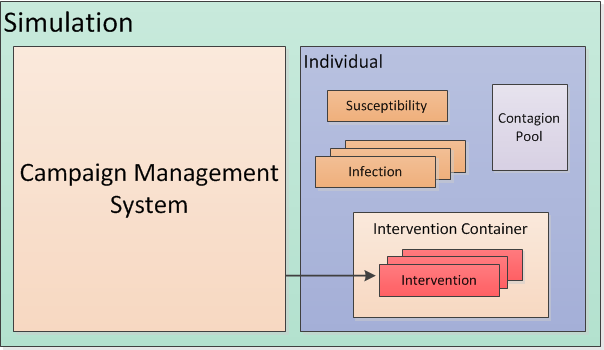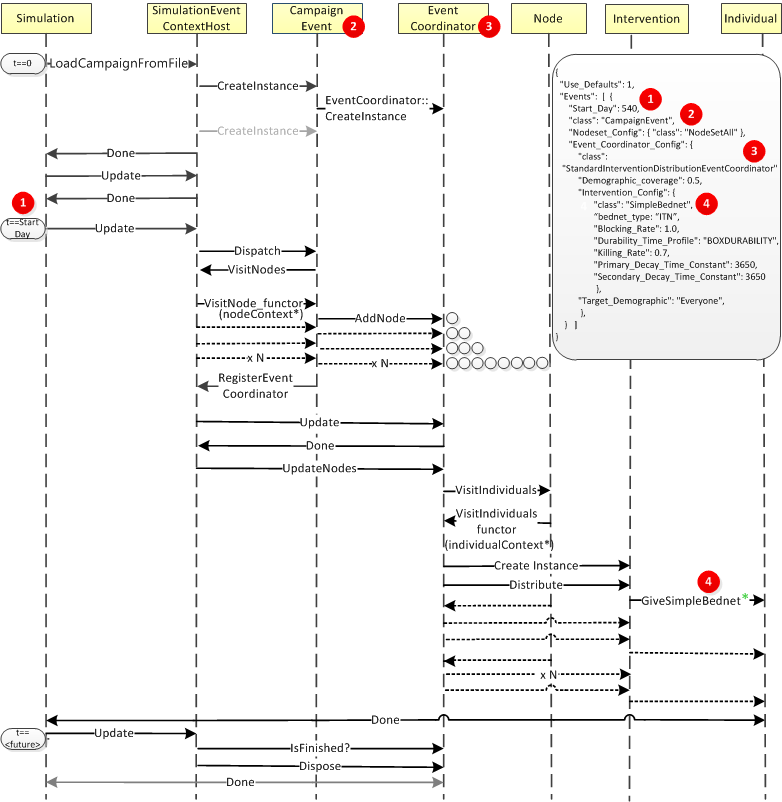Campaign management¶
Campaigns are structured into campaign events that determine when, where, and to whom the intervention will be distributed and interventions that determine what is distributed, for example vaccines or other treatments. This section describes the software architecture used for managing campaigns.
Campaigns can be very simple, such as a single intervention with fixed parameters at a point in time, or a complex, adaptive, repetitive, and responsive combination of interventions. A Campaign is a collection of events that modify a simulation. An Event is a distribution within a campaign, and an Intervention is an item that is given out, such as a vaccine, a drug or a bednet.

Warning
If you modify the source code to add or remove configuration or campaign parameters, you may need to update the code used to produce the schema. You must also verify that your simulations are still scientifically valid.
Contents
Campaign events¶
A campaign event triggers the campaign management system to evaluate when, where, and to whom the intervention will be distributed. This section describes the SimulationEventContext, CampaignEvent, NodeSet, and EventCoordinator classes used to manage this process.
For more information on setting up campaign files, see Creating campaigns.
SimulationEventContext¶
The Simulation class has a nested helper class called SimulationEventContextHost, referred to as SimulationEventContext. It serves as the interface to, or manager of, CampaignEvents for the Simulation class.
Incoming: The Simulation to SimulationEventContext interface contains the following methods:
Method |
Description |
|---|---|
LoadCampaignFromFile() |
Loads the campaign file during simulation initialization (t=0). |
RegisterEventCoordinator() |
Registers new event coordinators. Also used by CampaignEvent during activation to notify the SimulationEventContext of a new active EventCoordinator. |
Update() |
Advances the state at each time step. |
VisitNodes() |
Called from CampaignEvent during its activation. CampaignEvent is not a Node container, so it needs to communicate with the Simulation class to do anything with nodes. |
Outgoing: The SimulationEventContext communicates with CampaignEvents and EventCoordinators, which are described below.
CampaignEvent¶
The CampaignEvent class exists primarily as an initialization-time, minimal intelligence container with a 1-to-1 mapping for CampaignEvents found in the JSON campaign file. They do not do much in the way of run-time campaign distribution or control.
Incoming: The public interface for CampaignEvent contains the following methods:
Method |
Description |
|---|---|
CreateInstance() |
For each campaign event that the SimulationEventContext finds in the campaign file, it creates a corresponding CampaignEvent instance via CampaignEventFactory. The nested JSON elements in a campaign event are stored as an opaque (that is, unparsed) JSON object known as Event_Coordinator_Config. Immediate parameters like Start_Day are parsed out of the JSON and stored in explicit variables in the CampaignEvent class. |
Dispatch() |
In its steady-state, the SimulationEventContext checks the start day for all existing CampaignEvents and invokes this method to when the time step matches the start day. |
Outgoing: The CampaignEvent communicates with two other classes: NodeSet and EventCoordinator.
NodeSet¶
The NodeSet class parses the Nodeset_Config and helps the EventCoordinator determine if a given node is included in a particular intervention distribution. It can be as simple as NodeSetAll, which includes all nodes, or something much more involved. Usual cases include NodeSetPolygon and NodeSetCommunityList.
Incoming: The public interface for NodeSet contains the following methods:
Method |
Description |
|---|---|
Contains() |
The caller passes a Node via the INodeEventContext interface and gets back a Boolean. The NodeSet class completely encapsulates whatever logic is used to evaluate node membership. |
EventCoordinator¶
EventCoordinator is a base type that contains most of the functionality in the event distribution mechanism. There are two actual EventCoordinator classes implemented, but you can new implementations easily by creating a new EventCoordinator class.
Incoming: There are four classes or class groups that make calls into EventCoordinator:
CampaignEvents, which create and activate them.
The SimulationEventContext that invokes their steady-state methods.
Nodes (via the NodeEventContext helper class)
Interventions, which get EventCoordinator-level configuration data needed for intervention execution.
The public interface for EventCoordinator contains the following methods:
Method |
Description |
|---|---|
AddNode() |
Invoked by CampaignEvent::Dispatch() to allow the EventCoordinator to act as a node container and have access to all its constituent nodes via the INodeEventContext interface. Note The AddNode calls actually come via a delegate function that is in the EventCoordinator, but is invoked from the VisitNodes method up in the SimulationEventContext. The CampaignEvent passes the delegate function it wants used when it calls SimulationEventContext::VisitNodes() . This circuitous journey is needed because EMOD operates on a node-by-node basis and the SimulationEventContext, not the CampaignEvent, is the primary node container. |
CreateInstance() |
During their instantiation, CampaignEvents create EventCoordinators as the CampaignEvents parse the Event_Coordinator_Config, which specifies the class name and is passed by SimulationEventContext. Nothing then happens until CampaignEvent::Dispatch() is called. |
IsFinished() |
When an EventCoordinator determines that it is finished distributing its interventions, it sets an internal flag. The SimulationEventContext queries the IsFinished() function on each registered EventCoordinator and disposes of it if true. An EventCoordinator can activate and complete in a single time step, or it could last the entire length of the simulation. |
Update() |
The SimulationEventContext calls this on all registered EventCoordinators to advance their state at each time step. This method exists for global EventCoordinator communication and logic. |
UpdateNodes() |
Distributes the actual intervention. For the simplest possible use case, an EventCoordinator will distribute an intervention on its start day and then finish in that same time step. However, an EventCoordinator may implement repeating interventions, phased distributions, or sustained distributions that are contingent on node or individual attributes. |
Outgoing: The outgoing function calls consist of the distribution of the intervention either to individuals or nodes. For the interface between the EventCoordinator and the actual Intervention, the EventCoordinator calls InterventionFactory and passes it the remaining unparsed JSON from the campaign file. Namely, this is the Intervention_Config, the actual intervention-level campaign parameters including the intervention class. The InterventionFactory returns the newly created intervention instance for each individual via a one of two types of IDistributableIntervention interfaces.
Interventions¶
Interventions are the actual objects aimed at reducing the spread of disease, such as a vaccine or drug. THey can be either distributed to individuals or to nodes. For example, a vaccine is an individual-distributed intervention and a larvicide is a node-distributed intervention. Intervention is an abstract type class and specific interventions are classes that implement either IDistributableIntervention, for individual-distributed interventions, or INodeDistributableIntervention, for node-distributed interventions.
The determination of whether an intervention is individual-distributed or node-distributed is contained by logic in InterventionFactory. At the beginning of the EventCoordinator::UpdateNodes()**method, the **InterventionFactory is queried with the unparsed JSON campaign file to see if it returns an INodeDistributableInterface pointer. If it does, the intervention is executed as a node-distributed intervention; if it does not, the individual- distributed intervention execution is used.
Incoming: The interface to the abstract type Intervention class is the Distribute() method. It functions slightly differently for each intervention type.
Outgoing: Intervention is an abstract type that interacts with Nodes or IndividualHumans with an interface specific to that intervention type. The intervention calls QueryInterface on the container to ask for a consumer interface, for example IBednetConsumer. If supported, a Give method specific to that intervention will be called, for example, GiveBednet(this) to give itself to this individual. It is then up to the internal IndividualHuman or Node logic to decide what to do with this intervention.
Individual-distributed interventions¶
An individual-distributed intervention implements IDistributableIntervention, a container for the actual parameter name-value pairs from the campaign file, that is contained by an IndividualContainer, an IndividualHuman helper class. The EventCoordinator calls IDistributableIntervention::Distribute(), passing the pointer IIndividualHumanDistributionContext, which provides an ISupports interface to the individual by which the intervention can request a consumer interface. This interface can then be used with Give().
In the EventCoordinator::UpdateNodes() method, the EventCoordinator organizes the distribution of Interventions to IndividualHumans mediated by Nodes, which contain the IndividualHuman objects. The EventCoordinator also applies campaign parameters at the event coordinator level (for example, Target_Demographic, Demographic_Coverage, Num_Repetitions, and Days_Between_Reps) which mainly consists of filtering the distribution to individuals based on individual attributes.
Node-distributed interventions¶
A node-distributed intervention implements INodeDistributableIntervention, a container for the actual parameter name-value pairs from the campaign file, that is contained by a Node. The EventCoordinator calls INodeDistributableIntervention::Distribute(), passing the pointer INodeEventContext, which provides an ISupports interface to the individual by which the intervention can request a consumer interface. This interface can then be used with Give(). Similar to individual-distributed interventions, the EventCoordinator also applies campaign parameters for filtering the distribution.
The architectural diagram below illustrates how campaign file settings are processed by an EMOD simulation.

EMOD campaign architecture¶